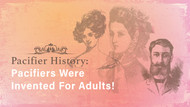Before Babies, Pacifiers Were For Adults
Posted by Pacifier Addict Team on 2023 Aug 25th
When you think of pacifiers, images of infants and toddlers likely come to mind. However, you may be surprised to learn that pacifiers were not originally invented for babies at all. In fact, the first pacifiers were designed explicitly for adults in the 19th century.
In the early 1800s, certain common habits like thumb sucking were discouraged in Western society. There was a widespread belief that these habits could cause health issues if done excessively over time. Religious figures preached strongly against such acts, looking for solutions to curb these behaviors.
This cultural backdrop led to pacifiers becoming popularized as “soothing devices” in the Victorian era. Rubber and silicone nipples, teats, and dummies were created with the purpose of preventing compulsive thumb sucking in both children and adults. Pacifiers served as alternatives for oral stimulation and comfort.
Companies began making pacifiers and marketing them as remedies for troublesome habits. Advertisements from the 1800s depict teenagers and adults using pacifiers instead of their thumbs. This demonstrated a way they could avoid societal wrath over such acts.
Adoption of pacifiers spread rapidly, with many parents having their children use them frequently. Schools and some workplaces encouraged pacifier use to promote more upright living. Dentists endorsed them as better for dental health than constant thumb sucking.
Doctors warned against overuse of pacifiers for potential impact on teeth and speech development. However, they were still largely deemed as moral alternatives to sucking one's thumb excessively. Pacifier use among adults persisted into the early 1900s before cultural perspectives gradually evolved.
As public opinions became more progressive, pacifiers as “soothing devices” fell out of favor with adults. However, their usefulness had already become rooted for calming infants. So pacifiers remained commonplace, just with babies as the new target users.
Today, pacifiers are quintessential symbols of childhood. But looking back reveals how they became widespread due to different attitudes in early Western society. The origin of pacifiers reflects desire for order during the Victorian era.
While pacifiers served questionable early purposes, they are now cherished by parents and children alike. Evolving cultural beliefs transformed them into items associated with purity and comfort rather than preventing “bad habits.”
So next time you see a pacifier, consider how society and tools influence one another. An item created with restrictive goals became an emblem of nurturing love. With open minds, we can re-evaluate how to employ objects for good.
 USD
USD  CAD
CAD
 Euro
Euro
 British Pound
British Pound

